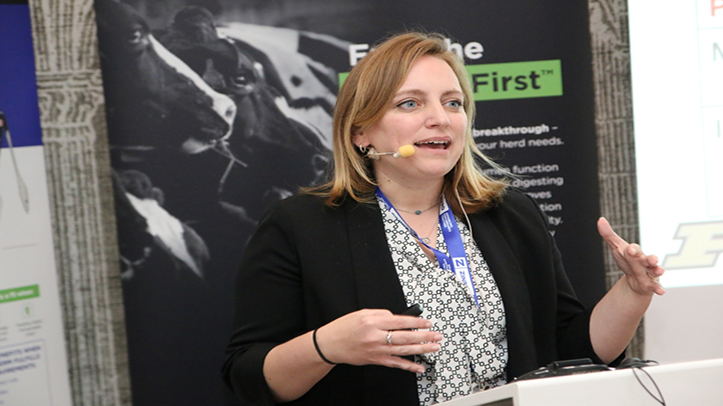Keeping cows in optimum condition before calving is absolutely critical to both cow and calf health – and new research has shown how important tailored nutrition is to this.
Research by Purdue University in the US has shown a clear link between cow muscle mass during the dry period and calf birthweight, as well as subsequent higher milk yields. And the key to this is advancement in dairy nutrition, to optimise the rumen environment and precisely meet the animal’s needs.
Speaking at the recent Zinpro IsoFerm Roadshow, which visited the UK, Poland and Germany, Dr Jackie Boerman, associate professor at Purdue University, said: “Skeletal muscle is a critical tissue for dairy cattle. While we have often thought of adipose (fat) as an energy store that can be accreted and depleted based on energy balance, skeletal muscle is also a dynamic tissue that changes across the lactation.”
Cows can lose between 3% and 17% of their body weight after calving, when nutritional demands exceed their ability to consume enough feed. Breaking down muscle releases stored protein for both amino acid and energy requirements. And depletion can begin before calving, to help with foetal development and prepare for the demands of lactation. “Ultrasound images take before and after calving show that muscle depth can decrease by 30-40% during early lactation,” said Professor Boerman.
Trials have shown that cows with higher muscle mass before calving produced heavier calves – at 48.8kg versus 45.2kg for those with lower muscle mass. And they then mobilised more of that muscle after calving – on average 1.54cm of muscle against 0.52cm in the cows with less muscle. This then released more protein for milk production, at 47.8kg of energy-corrected milk per day versus 41.4kg in low muscle cows.
“Understanding how and when muscle depletion occurs, and how nutrition can impact this process, is important for improving cow welfare and optimising milk yields,” said Professor Boerman. “The goal is to support the cow’s health through all stages of lactation, helping her to produce the highest quality milk while maintaining muscle mass and overall well-being.”
This is where targeted nutrition comes into play. For many years, research has focused on lactating cow nutrition, with isoacids like Zinpro IsoFerm proven to help rumen bacteria to produce microbial protein and digest fibres, releasing volatile fatty acids that are used to make milk and replenish energy stores.
More recently, researchers have examined the impact of feeding isoacids during the dry period. Improving rumen efficiency at this time boosts dry matter intakes, helps build muscle mass, and reduces the extent of negative energy balance after calving, said Dr Huw McConochie, dairy nutritionist at Zinpro.
“Any isoacids not used in the rumen are absorbed and can be used by the liver for glucose production, reducing the need for other energy sources and increasing milk production.”
A study at Purdue University fed cows with isoacids for 42 days prior to calving. At calving, they had a better energy status, with a 6% increase in circulating glucose levels and increased dry matter intake.
“Additionally, these cows produced 5% more milk at peak lactation and lost approximately 20kg less weight than cows that were not fed isoacids,” explained Dr McConochie.
“That’s 20kg of body weight that they don’t need to put back on, meaning that energy can instead go into milk production.”
He recommends feeding 40g/cow per day of Zinpro IsoFerm throughout the dry period and the fresh / high yielding lactation period. Not only does this increase milk yields and reduce weight loss, it also reduces the risk of transition diseases and boosts subsequent fertility.
The roadshow also saw the launch of a new frontier in dairy nutrition – Zinpro Availa ECM3. This unique amino acid complex includes bioactive nutrients that modulate the metabolic response to insulin sensitivity, helping animals to cope better with stress and calving.
“It enhances dry matter intake by up to 4.8% and boosts milk production by 2.5kg/day – or more under heat stress conditions,” said Dr McConochie.
“Cows fed through transition to the first 100 days in milk had 2.1% less body weight loss, improving energy status and herd health. At 5p/cow per day it’s a great addition to the Zinpro IsoFerm programme for transition cows.”


